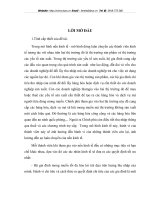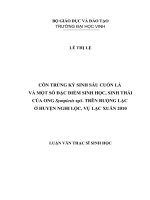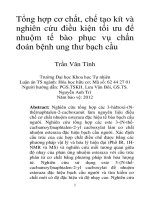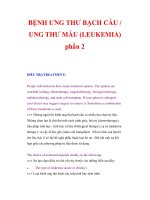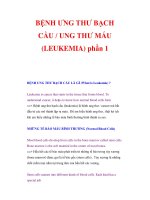Sàng lọc và phân tích đặc điểm phân tử các đột biến FLT3 xuất hiện trên bệnh nhân mắc bệnh ung thư bạch cầu cấp dòng tủy ở Việt Nam tt
Bạn đang xem bản rút gọn của tài liệu. Xem và tải ngay bản đầy đủ của tài liệu tại đây (552.64 KB, 12 trang )
Sàng lọc và phân tích đặc điểm phân tử các đột
biến FLT3 xuất hiện trên bệnh nhân mắc bệnh
ung thư bạch cầu cấp dòng tủy ở Việt Nam
Đỗ Thị Thanh Trung
Trường Đại học Khoa học Tự nhiên. Đại học Quốc gia Hà Nội
Luận văn Thạc sĩ ngành: Sinh học; Mã số : 60 42 01 14
Người hướng dẫn: TS. Phạm Bảo Yên
Năm bảo vệ: 2014
Abstract. Đã thiết lập được quy trình phát hiện các đột biến trên gen FLT3-ITD gây
ung thư bạch cầu cấp dòng tủy (đã được chuyển giao cho cơ sở y tế). Sàng lọc quy mô
phòng thí nghiệm cho thấy: tỷ lệ mẫu chứa đột biến gen FLT3-ITD là 15/200 mẫu,
chiếm 7,5% bệnh nhân AML. Trong mỗi mẫu chứa đột biến, có từ 1-2 đoạn lặp, mức độ
đột biến ở các mẫu là từ 25 - 70%. Đoạn lặp và đoạn gốc nằm cạnh nhau. Bước đầu
thiết lập được quy trình và thử nghiệm sàng lọc đột biến FLT3-TKD ở một số mẫu
Keywords. Sàng lọc; Phân tử; Đột biến gen; Ung thư bạch cầu; Sinh học thực nghiệm
Content
i
MỤC LỤC
MỞ ĐẦU 1
CHƢƠNG 1: TỔNG QUAN 3
1.1. Bệnh ung thƣ bạch cầu cấp dòng tủy (Acute Myeloid Leukemia-AML) 3
1.1.1. Thực trạng bệnh ung thư bạch cầu cấp dòng tủy và tình hình nghiên cứu
trên thế giới và ở Việt Nam 5
1.1.2. Phân loại các thể bệnh ung thư bạch cầu cấp dòng tủy 12
1.1.3. Các phương pháp chẩn đoán bệnh AML 13
1.1.4. Hướng điều trị đối với người bệnh ung thư bạch cầu cấp dòng tủy 14
1.2. Gen FLT3 và sự liên quan tới bệnh bạch cầu cấp dòng tủy 19
1.2.1. Cấu trúc và chức năng của gen FLT3 19
1.2.2. Các loại đột biến FLT3 20
1.2.3. Mối liên hệ giữa đột biến trên gen FLT3 và bệnh bạch cầu cấp dòng tủy21
1.2.4. Ý nghĩa của việc nghiên cứu gen FLT3 trong chẩn đoán và điều trị
AML 22
CHƢƠNG 2: NGUYÊN LIỆU VÀ PHƢƠNG PHÁP 24
2.1. Nguyên liệu 24
2.1.1. Mẫu máu 24
2.1.2. Các hóa chất và bộ kit 24
2.1.3. Máy móc và thiết bị 25
2.2. Phƣơng pháp 26
2.2.1. Tách DNA tổng số từ mẫu máu 26
2.2.2. Thiết kế cặp mồi đặc hiệu nhân bản đoạn gen có đột biến 27
ii
2.2.3. Nhân đoạn gen FLT3chứa đột biến với cặp mồi đặc hiệu bằng phản ứng
chuỗi polymerase (PCR) 27
2.2.4. Điện di agarose hoặc acrylamide để phân tích phổ băng đột biến 28
2.2.6. Nhân dòng đoạn gen FLT3 và đọc trình tự gen bằng phương pháp
Sanger 28
2.2.7. Một số phần mềm sử dụng trong luận văn 30
CHƢƠNG 3. KẾT QUẢ NGHIÊN CỨU VÀ THẢO LUẬN 31
3.1. Thu thập và tách chiết ADN hệ gen từ mẫu máu tổng số 31
3.2. Thiết kế và tối ƣu quy trình phát hiện đột biến gen FLT3-ITD 32
3.2.1. Thiết kế trình tự mồi 32
3.2.2. Thiết kế và tối ưu quy trình phát hiện đột biến FLT3-ITD 33
3.3. Bƣớc đầu sàng lọc trong quy mô phòng thí nghiệm 36
3.4. Kết quả đƣa sản phẩm PCR vào vectơ tái tổ hợp 37
3.5. Phân tích các đặc điểm phân tử của đột biến gen FLT3-ITD 40
3.5.1. Số lượng đột biến gen FLT3-ITD trong một mẫu (số đột biến/mẫu) 40
3.5.2. Kích thước đột biến 40
3.5.3. Trình tự đột biến 44
3.5.4. Mức độ đột biến 45
KẾT LUẬN 47
KIẾN NGHỊ 47
TÀI LIỆU THAM KHẢO 48
TÀI LIỆU THAM KHẢO
Tiếng Việt
1. Kiều Thị Vân Anh, Vũ Minh Phương, Nguyễn Thiên Lữ, Phạm Quang Vinh
(2012), “Bước đầu nghiên cứu gen NPM1 - muta và FLT3-ITD trên bệnh
nhân Lơ xê mi cấp dòng tủy”, Y học Việt Nam, 392, tr.64-68.
2. Trần Thái Bình, Lâm Thị Mỹ (2005). Giá trị phương pháp hình thái học - hoá
tế bào so với phương pháp dấu ấn miễn dịch trong chẩn đoán phân dòng
leucemi cấp ở trẻ em. Y học TP. Hồ Chí Minh 9 (Sup.1): 59-64.
3. Nguyễn Phương Liên, Nguyễn Tấn Bỉnh (2007),“Phân loại bệnh bạch cầu cấp
bằng dấu ấn miễn dịch tế bào”,Y học TP. Hồ Chí Minh, 11(1): 34-39
4. Phan Nguyễn Thanh Vân (2013), Ứng dụng kỹ thuật khuếch đại gien khảo sát
các tổ hợp gien thường gặp trong bệnh lý bạch cầu cấp, Luận án tiến sĩ y
học, Đại học Y Dược Thành phố Hồ Chí Minh.
Tiếng Anh
5. Ammatuna E., Noguera N.I., Zangrilli D., Curzi P., Panetta P., Bencivenga
P., Amadori S., Federici G., and Lo-Coco F. (2005), “Rapid detection of
nucleophosmin (NPM1) mutations in acute myeloid leukemia by denaturing
HPLC”, Clinical chemistry, 51 (11), pp. 2165-2167.
6. Bagrintseva K., Geisenhof S., Kern R., Eichenlaub S., Reindl C., Ellwart
J.W., Hiddemann W., and Spiekermann K. (2005), “FLT3-ITD-TKD dual
mutants associated with AML confer resistance to FLT3 PTK inhibitors and
cytotoxic agents by overexpression of Bcl-x(L)”, Blood, 105 (9), pp. 3679-
3685.
7. Barjesteh Van Waalwijk Van Doorn-Khosrovani S., Erpelinck C., Meijer J.,
Van Oosterhoud S., Van Putten W.L., Valk P.J., Berna Beverloo H., Tenen
D.G., Lowenberg B., and Delwel R. (2003), “Biallelic mutations in the
CEBPA gene and low CEBPA expression levels as prognostic markers in
intermediate-risk AML”, Hematology Journal 4(1), pp. 31-40.
8. Barry E.V., Clark J.J., Cools J., Roesel J., and Gilliland D.G. (2007),
“Uniform sensitivity of FLT3 activation loop mutants to the tyrosine kinase
inhibitor midostaurin”, Blood, 110 (13), pp. 4476-4479.
9. Boonthimat C., Identification of NPM1 mutation and its prognostic impact in
thai adult acute myeloid leukemia, in Faculty of Graduate Studies. 2008,
Mahidol: Mahidol University. p. 133.
10. Busque L. and Gilliland D.G. (1993), “Clonal evolution in acute myeloid
leukemia”, Blood, 82 (2), pp. 337-342.
11. Cairoli R., Beghini A., Grillo G., Nadali G., Elice F., Ripamonti C.B.,
Colapietro P., Nichelatti M., Pezzetti L., Lunghi M., Cuneo A., Viola A.,
Ferrara F., Lazzarino M., Rodeghiero F., Pizzolo G., Larizza L., and Morra
E. (2006), “Prognostic impact of c-KIT mutations in core binding factor
leukemias: an Italian retrospective study”, Blood, 107 (9), pp. 3463-3468.
12. Clark J.J., Cools J., Curley D.P., Yu J.C., Lokker N.A., Giese N.A., and
Gilliland D.G. (2004), “Variable sensitivity of FLT3 activation loop
mutations to the small molecule tyrosine kinase inhibitor MLN518”, Blood,
104 (9), pp. 2867-2872.
13. Cools J., Mentens N., Furet P., Fabbro D., Clark J.J., Griffin J.D., Marynen
P., and Gilliland D.G. (2004), “Prediction of resistance to small molecule
FLT3 inhibitors: implications for molecularly targeted therapy of acute
leukemia”, Cancer research, 64 (18), pp. 6385-6389.
14. Dohner K., Schlenk R.F., Habdank M., Scholl C., Rucker F.G., Corbacioglu
A., Bullinger L., Frohling S., and Dohner H. (2005), “Mutant nucleophosmin
(NPM1) predicts favorable prognosis in younger adults with acute myeloid
leukemia and normal cytogenetics: interaction with other gene mutations”,
Blood, 106 (12), pp. 3740-3746.
15. Falini B., Mecucci C., Tiacci E., Alcalay M., Rosati R., Pasqualucci L., La
Starza R., Diverio D., Colombo E., Santucci A., et al. (2005), “Cytoplasmic
nucleophosmin in acute myelogenous leukemia with a normal karyotype”,
New England Journal of Medicine, 352 (3), pp. 254-266.
16. Fröhling S., Scholl C., Levine R.L., Loriaux M., Boggon T.J., Bernard O.A.,
Berger R., Döhner H., Döhner K., Ebert B.L., et al. (2007), “Identification of
driver and passenger mutations of FLT3 by high-throughput DNA sequence
analysis and functional assessment of candidate alleles”, Cancer cell, 12 (6),
pp. 501-513.
17. Gilliland D.G. (2003), “FLT3-activating mutations in acute promyelocytic
leukaemia: a rationale for risk-adapted therapy with FLT3 inhibitors”, Best
Practice & Research Clinical Haematology, 16 (3), pp. 409-417.
18. Gilliland D.G. and Griffin J.D. (2002), “Role of FLT3 in leukemia”, Current
opinion in hematology, 9 (4), pp. 274-281.
19. Gilliland D.G. and Griffin J.D. (2002), “The roles of FLT3 in hematopoiesis
and leukemia”, Blood, 100 (5), pp. 1532-1542.
20. Ho P.A., Alonzo T.A., Gerbing R.B., Pollard J., Stirewalt D.L., Hurwitz C.,
Heerema N.A., Hirsch B., Raimondi S.C., Lange B., Franklin J.L., Radich
J.P., and Meshinchi S. (2009), “Prevalence and prognostic implications of
CEBPA mutations in pediatric acute myeloid leukemia (AML): a report from
the Children's Oncology Group”, Blood, 113 (26), pp. 6558-6566.
21. Jiang J., Paez J.G., Lee J.C., Bo R., Stone R.M., Deangelo D.J., Galinsky I.,
Wolpin B.M., Jonasova A., Herman P., Fox E.A., Boggon T.J., Eck M.J.,
Weisberg E., Griffin J.D., Gilliland D.G., Meyerson M., and Sellers W.R.
(2004), “Identifying and characterizing a novel activating mutation of the
FLT3 tyrosine kinase in AML”, Blood, 104 (6), pp. 1855-1858.
22. Kelly L.M., Yu J C., Boulton C.L., Apatira M., Li J., Sullivan C.M.,
Williams I., Amaral S.M., Curley D.P., Duclos N., Neuberg D., Scarborough
R.M., Pandey A., Hollenbach S., Abe K., Lokker N.A., Gilliland D.G., and
Giese N.A. (2002), “CT53518, a novel selective FLT3 antagonist for the
treatment of acute myelogenous leukemia (AML)”, Cancer cell, 1 (5), pp.
421-432.
23. Kesarwani M., Huber E., and Azam M. (2013), “Overcoming AC220
resistance of FLT3-ITD by SAR302503”, Blood Cancer Journal, 3, pp.
e138.
24. Kim H J., Ahn H., Jung C., Moon J., Park C H., Lee K O., Kim S H., Kim
Y K., Kim H J., Sohn S., Kim S., Lee W., Kim K., Mun Y C., Kim H.,
Park J., Min W S., Kim H J., and Kim D. (2013), “KIT D816 mutation
associates with adverse outcomes in core binding factor acute myeloid
leukemia, especially in the subgroup with RUNX1/RUNX1T1
rearrangement”, Ann Hematol, 92 (2), pp. 163-171.
25. Kim Y.K., Kim H.N., Lee S.R., Ahn J.S., Yang D.H., Lee J.J., Lee I.K., Shin
M.G., and Kim H.J. (2010), “Prognostic significance of nucleophosmin
mutations and FLT3 internal tandem duplication in adult patients with
cytogenetically normal acute myeloid leukemia”, Korean Journal of
Hematology, 45 (1), pp. 36-45.
26. Kiyoi H., Naoe T., Nakano Y., Yokota S., Minami S., Miyawaki S., Asou N.,
Kuriyama K., Jinnai I., Shimazaki C., Akiyama H., Saito K., Oh H., Motoji
T., Omoto E., Saito H., Ohno R., and Ueda R. (1999), “Prognostic
implication of FLT3 and N-RAS gene mutations in acute myeloid leukemia”,
Blood, 93 (9), pp. 3074-3080.
27. Kiyoi H., Towatari M., Yokota S., Hamaguchi M., Ohno R., Saito H., and
Naoe T. (1998), “Internal tandem duplication of the FLT3 gene is a novel
modality of elongation mutation which causes constitutive activation of the
product”, Leukemia, 12 (9), pp. 1333-1337.
28. Kohler G. and Milstein C. (1975), “Continuous cultures of fused cells
secreting antibody of predefined specificity”, Nature, 256 (5517), pp. 495-
497.
29. Kronke J., Bullinger L., Teleanu V., Tschurtz F., Gaidzik V.I., Kuhn M.W.,
Rucker F.G., Holzmann K., Paschka P., Kapp-Schworer S., et al. (2013),
“Clonal evolution in relapsed NPM1-mutated acute myeloid leukemia”,
Blood, 122 (1), pp. 100-108.
30. Lee B.H., Tothova Z., Levine R.L., Anderson K., Buza-Vidas N., Cullen
D.E., Mcdowell E.P., Adelsperger J., Frohling S., Huntly B.J., Beran M.,
Jacobsen S.E., and Gilliland D.G. (2007), “FLT3 mutations confer enhanced
proliferation and survival properties to multipotent progenitors in a murine
model of chronic myelomonocytic leukemia”, Cancer cell, 12 (4), pp. 367-
380.
31. Lin L.I., Chen C.Y., Lin D.T., Tsay W., Tang J.L., Yeh Y.C., Shen H.L., Su
F.H., Yao M., Huang S.Y., and Tien H.F. (2005), “Characterization of
CEBPA mutations in acute myeloid leukemia: most patients with CEBPA
mutations have biallelic mutations and show a distinct immunophenotype of
the leukemic cells”, Clinical Cancer Research, 11 (4), pp. 1372-1379.
32. Lu C., Ward P.S., Kapoor G.S., Rohle D., Turcan S., Abdel-Wahab O.,
Edwards C.R., Khanin R., Figueroa M.E., Melnick A., Wellen K.E.,
O'rourke D.M., Berger S.L., Chan T.A., Levine R.L., Mellinghoff I.K., and
Thompson C.B. (2012), “IDH mutation impairs histone demethylation and
results in a block to cell differentiation”, Nature, 483 (7390), pp. 474-478.
33. Ly B.T.K., Chi H.T., Yamagishi M., Kano Y., Hara Y., Nakano K., Sato Y.,
and Watanabe T. (2013), “Inhibition of FLT3 expression by green tea
catechins in FLT3 mutated-AML cells”, PLoS ONE, 8 (6), pp. 1-9.
34. Malek S.N., Update on the molecular biology of myelogenous leukemia:
clinical implications 2011: American Society of Clinical Oncology p. 231-
236.
35. Marcucci G., Maharry K., Wu Y.Z., Radmacher M.D., Mrozek K., Margeson
D., Holland K.B., Whitman S.P., Becker H., Schwind S., et al. (2010),
“IDH1 and IDH2 gene mutations identify novel molecular subsets within de
novo cytogenetically normal acute myeloid leukemia: a Cancer and
Leukemia Group B study”, Journal of Clinical Oncology, 28 (14), pp. 2348-
2355.
36. Meshinchi S. and Appelbaum F.R. (2009), “Structural and functional
alterations of FLT3 in acute myeloid leukemia”, Clinical Cancer Research,
15 (13), pp. 4263-4269.
37. Meshinchi S., Stirewalt D.L., Alonzo T.A., Boggon T.J., Gerbing R.B.,
Rocnik J.L., Lange B.J., Gilliland D.G., and Radich J.P. (2008), “Structural
and numerical variation of FLT3/ITD in pediatric AML”, Blood, 111 (10),
pp. 4930-4933.
38. Murphy K.M., Levis M., Hafez M.J., Geiger T., Cooper L.C., Smith B.D.,
Small D., and Berg K.D. (2003), “Detection of FLT3 internal tandem
duplication and D835 mutations by a multiplex polymerase chain reaction
and capillary electrophoresis assay”, Journal of Molecular Diagnostic, 5 (2),
pp. 96-102.
39. Nadler L.M., Stashenko P., Hardy R., Kaplan W.D., Button L.N., Kufe
D.W., Antman K.H., and Schlossman S.F. (1980), “Serotherapy of a patient
with a monoclonal antibody directed against a human lymphoma-associated
antigen”, Cancer research, 40 (9), pp. 3147-3154.
40. Nakao M., Janssen J.W., Erz D., Seriu T., and Bartram C.R. (2000),
“Tandem duplication of the FLT3 gene in acute lymphoblastic leukemia: a
marker for the monitoring of minimal residual disease”, Leukemia, 14 (3),
pp. 522-524.
41. Noguera N.I., Ammatuna E., Zangrilli D., Lavorgna S., Divona M.,
Buccisano F., Amadori S., Mecucci C., Falini B., and Lo-Coco F. (2005),
“Simultaneous detection of NPM1 and FLT3-ITD mutations by capillary
electrophoresis in acute myeloid leukemia”, Leukemia, 19 (8), pp. 1479-
1482.
42. Pressman D. and Korngold L. (1953), “The in vivo localization of anti-
Wagner-osteogenic-sarcoma antibodies”, Cancer, 6 (3), pp. 619-623.
43. Ravandi F., Alattar M.L., Grunwald M.R., Rudek M.A., Rajkhowa T., Richie
M.A., Pierce S., Daver N., Garcia-Manero G., Faderl S., et al. (2013), “Phase
2 study of azacytidine plus sorafenib in patients with acute myeloid leukemia
and FLT-3 internal tandem duplication mutation”, Blood, 121 (23), pp. 4655-
4662.
44. Renneville A., Roumier C., Biggio V., Nibourel O., Boissel N., Fenaux P.,
and Preudhomme C. (2008), “Cooperating gene mutations in acute myeloid
leukemia: a review of the literature”, Leukemia, 22 (5), pp. 915-931.
45. Schnittger S., Schoch C., Dugas M., Kern W., Staib P., Wuchter C., Loffler
H., Sauerland C.M., Serve H., Buchner T., Haferlach T., and Hiddemann W.
(2002), “Analysis of FLT3 length mutations in 1003 patients with acute
myeloid leukemia: correlation to cytogenetics, FAB subtype, and prognosis
in the AMLCG study and usefulness as a marker for the detection of minimal
residual disease”, Blood, 100 (1), pp. 59-66.
46. Small D. (2006), “FLT3 mutations: biology and treatment”, American
Society of Hematology, pp. 178-184.
47. Steudel C., Wermke M., Schaich M., Schäkel U., Illmer T., Ehninger G., and
Thiede C. (2003), “Comparative analysis of MLL partial tandem duplication
and FLT3 internal tandem duplication mutations in 956 adult patients with
acute myeloid leukemia”, Genes, Chromosomes and Cancer, 37 (3), pp. 237-
251.
48. Stirewalt D.L., Kopecky K.J., Meshinchi S., Appelbaum F.R., Slovak M.L.,
Willman C.L., and Radich J.P. (2001), “FLT3, RAS, and TP53 mutations in
elderly patients with acute myeloid leukemia”, Blood, 97 (11), pp. 3589-
3595.
49. Stirewalt D.L. and Radich J.P. (2003), “The role of FLT3 in haematopoietic
malignancies”, Nature Reviews Cancer, 3 (9), pp. 650-665.
50. Tallman M.S. (2005), “New strategies for the treatment of acute myeloid
leukemia including antibodies and other novel agents”, Hematology / the
Education Program of the American Society of Hematology. American
Society of Hematology. Education Program, pp. 143-150.
51. Thiede C., Steudel C., Mohr B., Schaich M., Schakel U., Platzbecker U.,
Wermke M., Bornhauser M., Ritter M., Neubauer A., Ehninger G., and
Illmer T. (2002), “Analysis of FLT3-activating mutations in 979 patients
with acute myelogenous leukemia: association with FAB subtypes and
identification of subgroups with poor prognosis”, Blood, 99 (12), pp. 4326-
4335.
52. Vardiman J.W., Harris N.L., and Brunning R.D. (2002), “The World Health
Organization (WHO) classification of the myeloid neoplasms”, Blood, 100
(7), pp. 2292-2302.
53. Vardiman J.W., Thiele J., Arber D.A., Brunning R.D., Borowitz M.J., Porwit
A., Harris N.L., Le Beau M.M., Hellstrom-Lindberg E., Tefferi A., and
Bloomfield C.D. (2009), “The 2008 revision of the World Health
Organization (WHO) classification of myeloid neoplasms and acute
leukemia: rationale and important changes”, Blood, 114 (5), pp. 937-951.
54. Yamamoto Y., Kiyoi H., Nakano Y., Suzuki R., Kodera Y., Miyawaki S.,
Asou N., Kuriyama K., Yagasaki F., Shimazaki C., et al. (2001), “Activating
mutation of D835 within the activation loop of FLT3 in human hematologic
malignancies”, Blood, 97 (8), pp. 2434-2439.
Website:
55. />symptoms-treatment-chemotherapy-radiotherapy-immunotherapy-stem-cell-
transplant-targeted-therapy-cost-abroad-medical-tourism.html
56.

